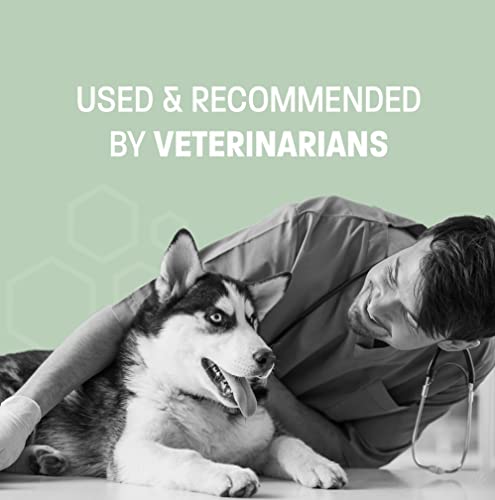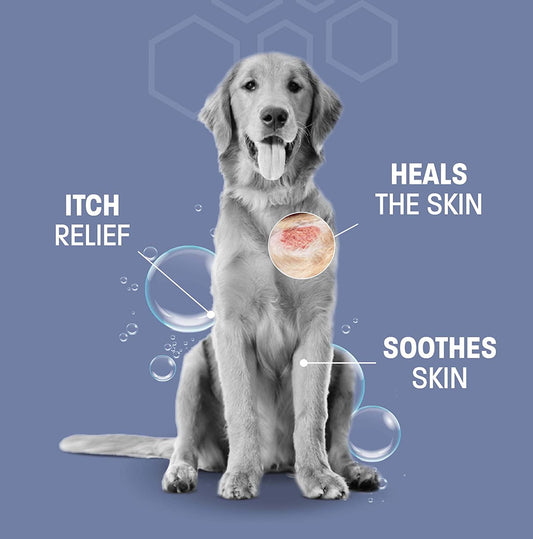One of the most common afflictions in dogs is an ear yeast infection. Join Pet Health Pros as we dive into its causes and how our specialized medicated products can help combat this nagging condition.
To understand the causes of yeast infection in dog ears, delve into the introductory section that provides a definition and overview of this common canine affliction. Gain insights into the potential triggers and underlying factors responsible for the presence of yeast and fungus in your furry friend's ears.
Definition and Overview of Yeast Infection in Dog Ears
Yeast infection in a dog's ears is common. It happens when yeast, normally present in small amounts, grows too much and disrupts the balance of the ear canal. Signs include itching, redness, discharge, and an unpleasant odor.
Yeast is a type of fungus that loves warm and moist places. Dog ears are perfect for this due to their shape and the presence of hair that traps moisture. Allergies, hormonal imbalances, and health conditions can contribute. Symptoms depend on the dog and stage of the infection. Left untreated, it can cause pain and hearing loss.
If you think your pup has a yeast infection, get help from a vet. They will examine and test samples. Treatment involves cleaning the ears regularly and using medication.
Preventing infections requires proper hygiene. Check ears for redness or discharge. After swimming or bathing, dry your pet's ears.
By being aware and seeking help when needed, you can keep your pooch's ears healthy and safe.
Causes of Yeast Infection in Dog Ears
To uncover the causes of yeast infection in dog ears, dive into common fungal species responsible for dog ear infections and the factors that contribute to these infections. Explore the culprits behind your furry companion's discomfort, shedding light on potential solutions for their ear health.
Common Fungal Species Responsible for Dog Ear Infections
Certain fungal species contribute to ear infections in dogs. Malassezia and Candida like warm, moist places, such as the ear canal. This leads to irritation and inflammation, making our furry friends uncomfortable.
Malassezia is a common fungus that likes to feed on skin and ear oils. Too much of this yeast-like fungus causes itching, redness, and a nasty odor.
Candida is another fungus found in small amounts in healthy dogs. However, it can grow quickly if the immune system is weak or antibiotics are used for too long.
Breeds with floppy ears or lots of hair in their ears are more likely to get infections because moisture gets trapped.
Tip: Regularly clean your dog's ears with a vet-recommended cleanser. Gently wipe away any debris or wax. Don't insert anything into the ear canal to avoid damage. If your pup has signs of an infection, see a vet.
Factors that Contribute to Yeast Infections in Dog Ears
We all know poor ear hygiene can cause yeast overgrowth. Moisture and debris create an ideal environment for yeast to flourish. Dogs with allergies, skin conditions, or weak immune systems are more prone to yeast infections. Certain breeds, such as Cocker Spaniels and Miniature Schnauzers, have issues due to their ear canal anatomy or hair growth patterns.
To prevent and manage yeast infections in dog ears, keep their ears clean. Use a vet-recommended solution to maintain healthy bacteria and reduce moisture. Identify and address any allergies, groom and remove hair where necessary, treat underlying skin conditions, and boost your dog's immune system with a balanced diet and exercise. Understand and address these contributing factors to keep your furry companion's ears healthy, reducing the risk of yeast infections.
Symptoms and Diagnosis of Yeast Infection in Dog Ears
To effectively identify and diagnose yeast infection in dog ears, understanding the symptoms is crucial. By being able to recognize the signs of this common condition, you can promptly seek appropriate treatment. In this section, we will explore how to identify signs of yeast infection in dogs and the diagnostic methods utilized to confirm these infections.
Identifying Signs of Yeast Infection in Dogs
If your pup is suffering from a yeast infection, watch for signs like itching, redness, and a smelly discharge. They may also shake their heads or scratch at their ears. Hair loss, scabs, and crusty skin are other common indicators.
If you suspect a yeast infection, look out for:
- Excessive scratching and rubbing of the ears.
- Redness, swelling, and inflammation in the affected area.
- A strong, unpleasant smell coming from the ears.
- Yellowish or brownish discharge in the ears.
- Signs of discomfort or pain when their ears are touched.
Note that these symptoms will vary depending on the severity and the dog's response. If any of these signs appear, contact your vet right away. Don't let them suffer – get professional help to address the issue and keep your pup healthy!
Diagnostic Methods for Confirming Yeast Infections
- Microscopic examination - to check for yeast cells.
- Culture test - to identify and analyze yeast species.
- Symptom evaluation - like redness, itchiness, inflammation, etc.
- Physical exam - to look for swelling and odor.
- Allergy testing - to check for allergens.
Plus, knowing your dog's medical history is helpful.
Treatment and Prevention of Yeast Infection in Dog Ears
To address the treatment and prevention of yeast infection in dog ears, equip yourself with the knowledge of effective solutions. Antifungal medications and topical treatments, along with proper ear hygiene and cleaning techniques, will help combat the infection. Additionally, adopting preventive measures can minimize the risk of future yeast infections.
Antifungal Medications and Topical Treatments
Antifungal meds and topical treatments are key for treating and preventing yeast infections in dog ears. Clotrimazole is a common antifungal cream. It stops yeast growth and reduces symptoms like itching and inflammation. Apple cider vinegar and coconut oil are also popular topical treatments. Diluted ACV creates an environment hostile to yeast. Coconut oil has antifungal properties and moisturizes the skin. Keeping your pup's ears clean and dry is important. And a balanced diet supports their immune system.
Proper Ear Hygiene and Cleaning Techniques
Fend off yeast infections in your pup's ears by following these straightforward steps!
- Firstly, have a look for redness, swelling and discharge.
- Then, use a vet-recommended cleaner on a cotton pad to clean the ear - no need to insert anything into their ear canal.
- If your dog has long fur in their ears, trim it to enable better air circulation and reduce the risk of moisture accumulation.
- Lastly, ensure regular cleaning depending on your pup's needs - ask your vet for advice.
Preventive Measures to Minimize the Risk of Yeast Infections
Caring for your pup's ears is essential! Gently wipe them with a damp cloth, or use an ear cleaner your vet has recommended. Plus, trim any excess hair around their ears to improve airflow and prevent moisture buildup.
It's important to feed your pup a balanced diet with essential nutrients to keep their immune system healthy. This is because a weakened immune system can increase the risk of yeast infections.
Additionally, watch out for environments with too much moisture, such as swimming pools and rainy areas. These can be breeding grounds for yeast.
Be sure to check for signs of irritation or inflammation, like redness, swelling, or foul odors. Have your vet take a look if you spot anything unusual.
Plus, certain breeds are more prone to yeast infections due to their anatomy, like dogs with floppy or narrow ear canals. If this applies to your pup, be extra vigilant in taking preventive steps.
Start taking action now to ensure your pup's well-being! By following these measures, you can minimize the risk of yeast infections. Give your loyal companion the care they deserve; take charge today!
Potential Complications and Long-term Effects of Untreated Yeast Infections
Untreated yeast infections in dogs can be hazardous. It may spread to their paws or skin, causing discomfort. It can also cause inflammation and irritation in the affected areas, leading to pain and making it hard for them to do daily activities. Plus, it can weaken their immune system, making them more prone to illnesses and infections.
However, not all dogs will face these long-term effects. It's best to get veterinary help and advice if you spot signs of infection in your pet's ears or other areas. To prevent yeast infections, clean and dry your dog's ears regularly.
Conclusion
Understanding is the first step towards effective treatment. With the guidance of Pet Health Pros and our medicated solutions, your dog can find relief from ear yeast infections.
Unravel the Mystery: What Causes Yeast Infections in Dog Ears?
Yeast infections in our pup's ears can be a worrying and persistent problem. To treat and stop them, it is essential to know what causes them. For example, too much moisture, allergies, or weak immune systems can trigger these infections.
It is essential to keep our dog's ears clean and dry. Moisture is the perfect place for fungi to grow. Pet owners must pay attention to allergies too. Identifying any allergens and making dietary changes or taking medicine can help to prevent yeast infections.
Dogs with weak immune systems are more prone to yeast infections. Taking care of any health conditions and giving supplements to support the immune system can help to stop these infections.
Remember, not all yeasts are bad. Malassezia pachydermatis is a fungus found on canine skin and ears. It only causes issues when it grows too much due to favorable conditions.
To sum up, it is crucial to understand the causes of yeast infections in dog ears. With proper hygiene, addressing allergies, and supporting your dog's immune system, you can keep the yeasts away. A healthy ear equals a happier pup!
Additional Resources and References
For tackling yeast infections in dog ears, there are several resources and suggestions to consider. Online pet health websites, scientific research articles, veterinary books, and animal care forums can all provide valuable information. Additionally, it's essential to consult with a veterinarian for personalized recommendations.
To prevent yeast growth, regular ear cleaning is important. Also, use an antifungal solution recommended by a vet. After swimming or bath time, be sure to dry the ears with a clean towel or cotton ball, too.
Lastly, address any underlying health issues, such as allergies or immune system imbalances, which can play a role in preventing yeast infections. By utilizing the knowledge provided in additional resources and following these suggestions, dog owners can effectively combat yeast infections in their pet's ears.
Frequently Asked Questions
Q: What causes yeast infection in dog ears?
A: Yeast infection in dog ears is commonly caused by the overgrowth of fungus called Malassezia. This can be triggered by factors such as allergies, moisture, lack of ventilation, or a weakened immune system.
Q: What are the symptoms of a yeast infection in dog ears?
A: Common symptoms include excessive itching, redness, inflammation, foul odor, discharge, and frequent shaking of the head. Some dogs may also have crusty or scaly skin around the ears.
Q: Can yeast infections in dog ears spread to other parts of the body?
A: Yes, if left untreated, yeast infections in dog ears can spread to other areas such as paws or skin folds. It is important to address the infection promptly to prevent further complications.
Q: How can I treat a yeast infection in my dog's ears?
A: Treatment usually involves cleaning the ears with a vet-recommended antifungal solution and applying topical antifungal medications. In severe cases, oral antifungal medications may be prescribed. Regular ear cleaning and maintaining proper hygiene are also crucial.
Q: Can I prevent yeast infections in my dog's ears?
A: While some dogs may be more prone to yeast infections, there are preventive measures you can take. Keep your dog's ears clean and dry, ensure proper ventilation, manage allergies, and regularly check for early signs of infection.
Q: When should I consult a vet for my dog's yeast infection?
A: It is advisable to consult a vet if your dog shows persistent or worsening symptoms, if the infection spreads or recurs frequently, or if you are unsure about the appropriate treatment. The vet can provide a proper diagnosis and recommend an effective treatment plan.








